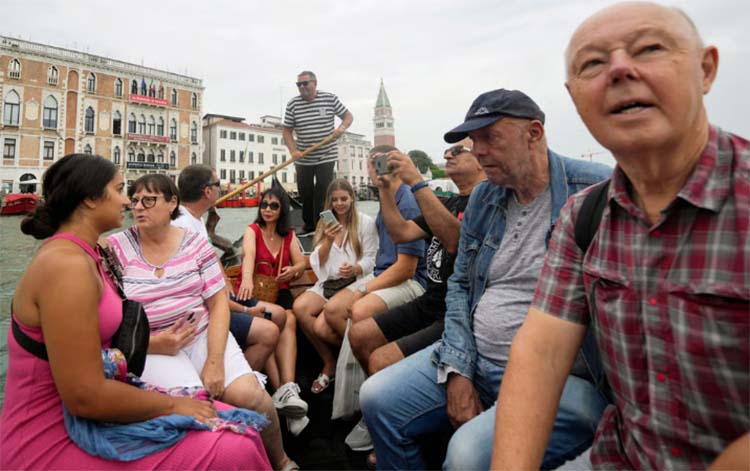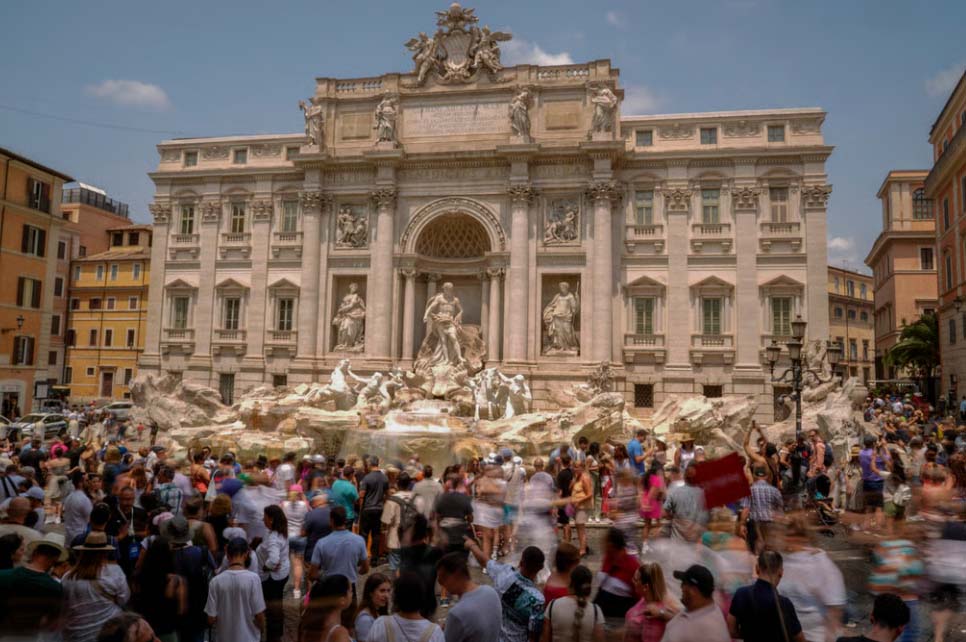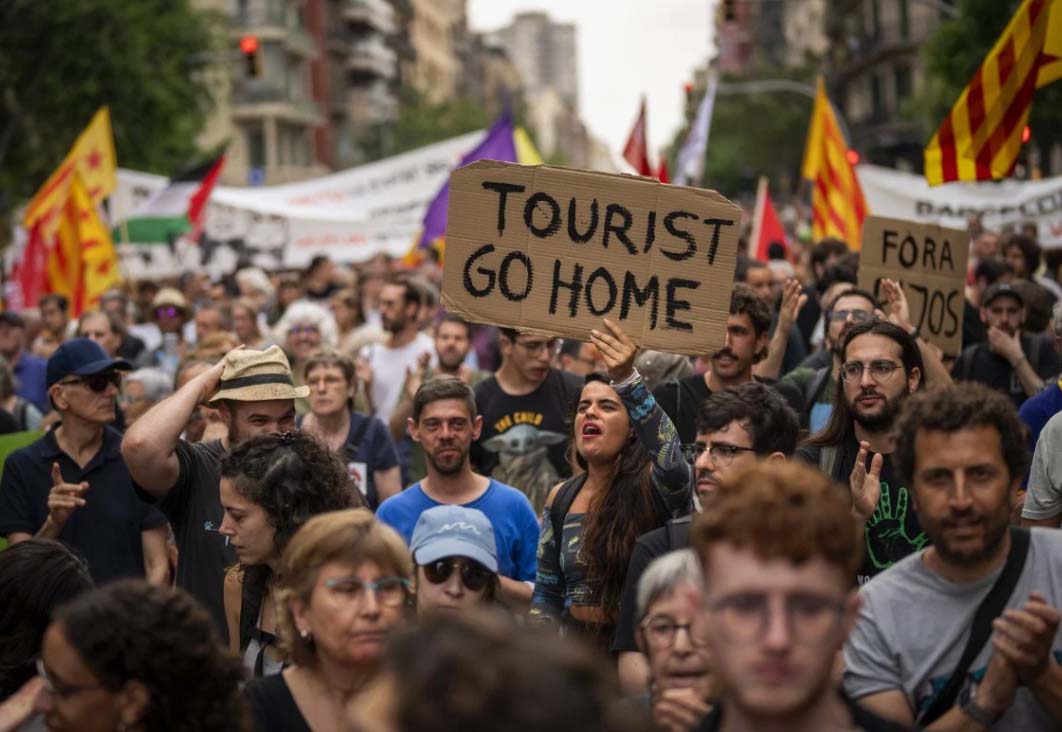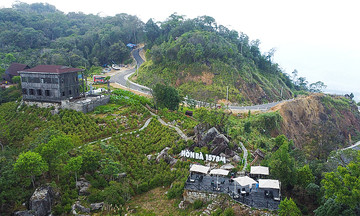Europe welcomed nearly 750 million international tourists in 2024, the most of any continent, according to a report by the United Nations World Tourism Organization. Over 70% of these visitors flocked to southern and western Europe.
This surge in tourism has placed immense pressure on popular tourist cities regarding accommodation, water supplies, and infrastructure. Crowds at famous check-in spots, a proliferation of ice cream shops, and the constant rumble of rolling suitcases on cobblestone streets have become commonplace. Across Europe, a growing wave of opposition to over-tourism is emerging, prompting some countries to implement control measures.
 |
Tourists on a gondola in Venice, Italy. Photo: AP |
Tourists on a gondola in Venice, Italy. Photo: AP
Several factors contribute to Europe's predicament: affordable airfare, social media influence, AI-powered travel planning, and stable economies in many countries. Visitors from the US, Japan, China, and the UK account for a significant portion, concentrating on destinations like Barcelona, Spain, and Venice, Italy. The influx of tourists during peak seasons creates a surge in demand for housing and resources.
France, the most visited country globally, receives around 100 million international tourists annually, with the Mediterranean region bearing the brunt of the impact. Spain comes in second with nearly 94 million visitors, almost double its population.
In France, the Louvre, the world's most visited museum, was forced to close in the middle of the month when staff went on strike to protest overcrowding. Thousands of pre-booked visitors were left waiting in the heat.
Anti-tourism protests have erupted across Spain. In Barcelona, water guns have become a symbol of resistance, used by protesters to spray tourists alongside banners proclaiming, "One more tourist, one fewer resident!". The Canary and Balearic Islands recorded over 15 million visitors in 2024, three times their local population.
 |
Tourists visit the Trevi Fountain, Italy. Photo: AP |
Tourists visit the Trevi Fountain, Italy. Photo: AP
Italy is also facing pressure in Venice, Rome, Capri, and Verona, the setting of Romeo and Juliet. On the Amalfi Coast, Uber has resorted to offering helicopter and private boat services to bypass traffic congestion during peak season.
Greece, which saw almost four times its population in tourists in 2024, is struggling with water, housing, and energy shortages, particularly on tourist islands like Santorini and Mykonos. Many areas are also facing prolonged droughts.
Experts and activists in many cities point out that the wave of tourism is transforming residential areas. Traditional shops are being replaced by souvenir stalls and global restaurant chains, and rent prices are soaring due to the boom in short-term rentals.
Angelos Varvarousis, an urban specialist based in Barcelona and Athens, warns that over-tourism is eroding local culture.
Faced with over-tourism and severe housing shortages in major cities, the governments of Spain, Greece, and Italy have introduced drastic measures to control visitor numbers and protect resources for local residents.
Spain has labeled the current housing crisis its "biggest governance challenge." In 5/2024, the government demanded that Airbnb remove nearly 66,000 listings deemed to be in violation of local regulations. Simultaneously, Barcelona announced plans to eliminate all 10,000 apartments currently licensed for short-term rentals by 2028. Officials stated the goal is to preserve housing for full-time residents.
Many other cities are also seeking ways to regulate tourist numbers by limiting overnight stays or charging fees for cruise ship passengers.
 |
Barcelona residents protest, demanding tourists go home in the summer of 2024. Photo: AP |
Barcelona residents protest, demanding tourists go home in the summer of 2024. Photo: AP
In Greece, from 1/7, visitors arriving on cruise ships will be charged a fee: €20 (approximately 530,000 VND) for popular destinations like Mykonos, and €5 (approximately 130,000 VND) for less-visited islands like Samos. The government is also encouraging tourists to explore quieter areas to alleviate pressure on popular hotspots.
To combat water shortages during summer, Greece has dispatched water tankers from the mainland to the islands and employed desalination technology to increase water supply. Additionally, the Acropolis in Athens has implemented timed entry slots to avoid overcrowding and heat, ensuring visitor safety.
Italy has taken similar steps, with Venice reintroducing entry fees for day-trippers after a trial run in 2024. The fee, ranging from €5 to €10 (approximately 130,000–260,000 VND), applies during peak season.
Despite local frustration, some tourism officials believe the issue can be managed with improved infrastructure. Italy's Tourism Minister, Daniel Santanche, suggests using AI to regulate visitor flow at crowded sites like the Uffizi Gallery in Florence, home to numerous artistic masterpieces. She proposes selling tickets in advance and emphasizes that most tourists concentrate in only about 4% of Italy's territory.
"Tourism needs to be an opportunity, not a threat, even for local communities," she said.
Anh Minh (SCMP)












